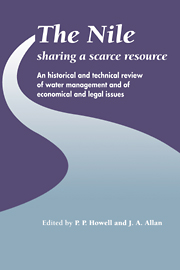 The Nile: Sharing a Scarce Resource
The Nile: Sharing a Scarce Resource Book contents
- Frontmatter
- Contents
- Preface
- List of Contributors
- Orthography
- Units and Conversion Factors
- Introduction
- I Environmental history of the Nile and its management
- II Nile management and factors affecting future management
- III Future utilisation of Nile waters
- IV Economic, international and legal issues
- 14 Evolving water demands and national development options
- 15 The Nile Basin: water management strategies
- 16 History of the Nile Basin and Lake Victoria basins through treaties
- 17 Principles and precedents in international law governing the sharing of Nile waters
- 18 Law and the River Nile: emerging international rules and the Sharia'h
- 19 Developing policies for harmonised Nile Waters development and management
- Index
18 - Law and the River Nile: emerging international rules and the Sharia'h
Published online by Cambridge University Press: 05 February 2012
- Frontmatter
- Contents
- Preface
- List of Contributors
- Orthography
- Units and Conversion Factors
- Introduction
- I Environmental history of the Nile and its management
- II Nile management and factors affecting future management
- III Future utilisation of Nile waters
- IV Economic, international and legal issues
- 14 Evolving water demands and national development options
- 15 The Nile Basin: water management strategies
- 16 History of the Nile Basin and Lake Victoria basins through treaties
- 17 Principles and precedents in international law governing the sharing of Nile waters
- 18 Law and the River Nile: emerging international rules and the Sharia'h
- 19 Developing policies for harmonised Nile Waters development and management
- Index
Summary
Introduction
The law governing the Nile waters can be assessed against a background of several legal traditions, including the domestic laws of individual riparians, documented decisions of federal courts in countries like Australia, Germany or the United States, existing regional arrangements on international rivers, Nile-specific agreements between the basin states, as well as customary law, particularly among the peoples of the basin. There is a vast literature on the subject, and the purpose of this chapter is not to review the subject overall but is much more modest in scope. Discussion will be limited to two traditions which could be of particular relevance to the subject of the Nile: the present reassessment and formulation of international watercourse systems law, and the Islamic legal tradition and some of its possible bearing on the law of water.
As for public international law, a survey of some recent developments is based on a comparison between the draft text established in the course of the 1980s by the International Law Commission, and the Restatement of the International Law Association in 1966, known as the Helsinki Rules. The factor-analysis approach, which is at the root of the international law experts' philosophy in both instances, will be assessed in the light of the Nile case. This is followed by an appraisal of some strands of the legal tradition offered by selected texts of the sharī'a, with particular emphasis on their possible contribution to a comprehensive legal agreement on the management of the Nile resources.
- Type
- Chapter
- Information
- The Nile: Sharing a Scarce ResourceA Historical and Technical Review of Water Management and of Economical and Legal Issues, pp. 365 - 384Publisher: Cambridge University PressPrint publication year: 1994
- 2
- Cited by
